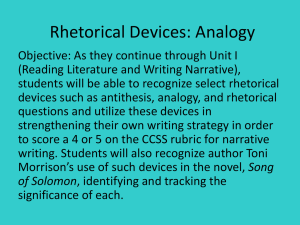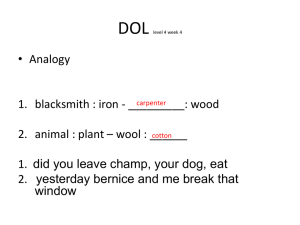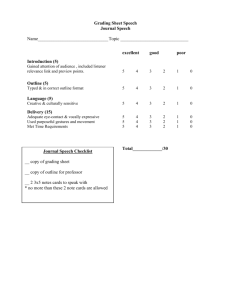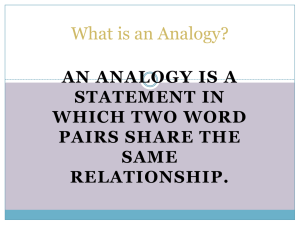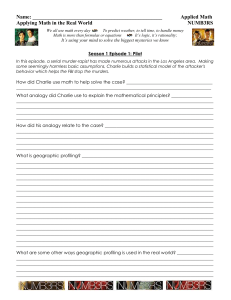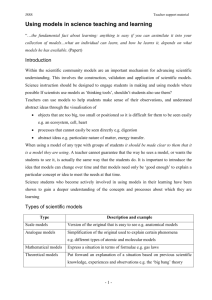Thinking with Models
advertisement
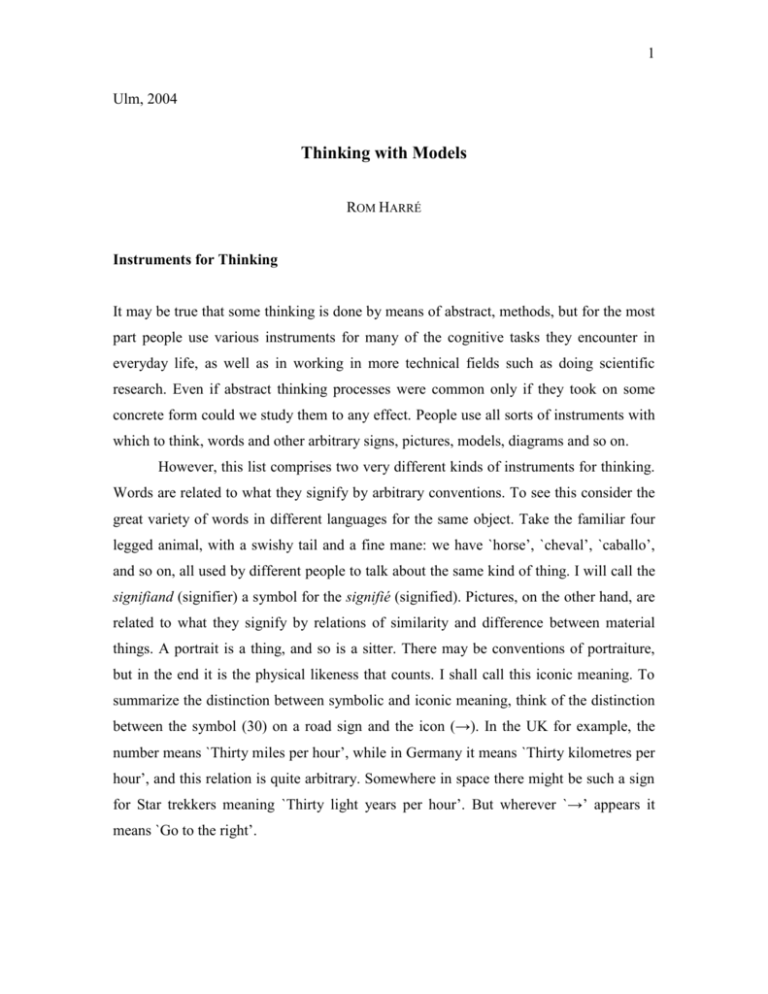
1 Ulm, 2004 Thinking with Models ROM HARRÉ Instruments for Thinking It may be true that some thinking is done by means of abstract, methods, but for the most part people use various instruments for many of the cognitive tasks they encounter in everyday life, as well as in working in more technical fields such as doing scientific research. Even if abstract thinking processes were common only if they took on some concrete form could we study them to any effect. People use all sorts of instruments with which to think, words and other arbitrary signs, pictures, models, diagrams and so on. However, this list comprises two very different kinds of instruments for thinking. Words are related to what they signify by arbitrary conventions. To see this consider the great variety of words in different languages for the same object. Take the familiar four legged animal, with a swishy tail and a fine mane: we have `horse’, `cheval’, `caballo’, and so on, all used by different people to talk about the same kind of thing. I will call the signifiand (signifier) a symbol for the signifié (signified). Pictures, on the other hand, are related to what they signify by relations of similarity and difference between material things. A portrait is a thing, and so is a sitter. There may be conventions of portraiture, but in the end it is the physical likeness that counts. I shall call this iconic meaning. To summarize the distinction between symbolic and iconic meaning, think of the distinction between the symbol (30) on a road sign and the icon (→). In the UK for example, the number means `Thirty miles per hour’, while in Germany it means `Thirty kilometres per hour’, and this relation is quite arbitrary. Somewhere in space there might be such a sign for Star trekkers meaning `Thirty light years per hour’. But wherever `→’ appears it means `Go to the right’. 2 In psychological terms we distinguish between symbolic thinking and iconic thinking, bearing in mind that there may be a fuzzy area between paradigm cases of each type of cognition. There rules for correct and fruitful ways for doing both kinds of thinking. If we are interested in maintaining truth through some stretch of reasoning and avoiding falsity and contradiction, there are the rules of logic. Meaning is maintained by other kinds of rules, such as syntax and rules of good style. Thinking iconically too has its rules, though only recently have they been the subject of systematic studies. An outline of the rules for good, fruitful for symbolic thinking is the topic of this discussion. We might call these the rules of analogic. There are many kinds of devices used in iconic thinking. In this paper we will narrow them down to one important kind only, models. What is a model? There are many uses of the word `model’. Broadly these fall into two groups. Sometimes by `model’ is meant an ideal form of something, such as a model answer, a model pupil or a fashion model. There are debates about whether the ideality of fashion models ought to define the proper shapes for men and women! Sometimes the word is used to denote an analogue of something, such as a model plane, or an architectural model. This is the sense of most importance in understanding scientific thinking. Recently the word `model’ has taken on a third use. Psychologists often talk of `my model’ when they mean their schema or even their concept for something. I believe that this is an unfortunate development, since it cuts across some very important distinctions. One cannot stoop the growth of language, of course. All one say is `take care that in using “model” in that sense one does not import some of the meaning of the other senses’. Why do we make or imagine an analogue model of some subject? This technique is brought into use when there is some difficulty in studying the subject itself. For example, the universe is too big, so Einstein, distinguished son of Ulm, imagined it as a kind of sphere, thought 4-dimensional. It may be too far away to study directly. It may be too hot, such as the interior of the sun. It may too small such as the molecular structure of 3 sugar. It may too ephemeral such as the dynamics of small scale human interactions, and so on. Let us look at some familiar examples. Television weather forecasters display the state of the atmosphere in their weather chart. They show areas of high and low pressure, with lines representing isobars, and arrows representing winds. The chart is a representation of iconic model of the atmosphere, simplified and greatly reduced in scale. Forecasters not only show the public the state of the weather but use similar charts to make predictions. Aircraft manufacturers do not build full scale versions of new airliners and then try to fly them. They make dozens of models at different scales, to explore how their designs would fare in reality. Model airliners are studied in a wind tunnel. These tunnels are themselves analogues of the atmosphere and of the conditions encountered by a plane in flight. The chart is an analogue of the atmosphere, and the model place an analogue of an airliner. To go deeper into the way analogues work in cognition we need to sketch the rules for using them effectively (Harré, 2004). Analogic: The Logic for Analogues 1. The formal requirements for something A to be an analogue of something else, B, can be summarized in three desiderata: A is like B in some respects (positive analogy) A is unlike B in some respects (negative analogy) A and B are like and unlike in ways that have not yet been investigated (neutral analogy) If A, the model, were exactly like its subject, it would not be a model but a copy. So there must be respects in which the model and its subject differ. What these are will depend on the topic, the use to which the model is put, practical matters like the feasibility of constructing the model in a usable form, and so on. Usually, there are aspects of the model and its subject that are not initially represented in the working analogy. These 4 aspects are the growing points for the model. They remain as open possibilities for later exploration. Creative use of models depends heavily on the ability of the model maker to exploit the neutral analogy. In deciding on the design of a new building both the architects and the clients make use of architectural models. The Maritim Hotel and Conference Centre is a striking building, and the choice of design must have been a matter of concern to Burgomeister and the Councillors of the city of Ulm. We can be sure that they did not wait until the building was finished alongside the banks of the Danube before they thought about how it looked. They would have been presented not only with blueprints, plans, but also with one or models, 3-diumensiponal representations of the building as it would look when finished. To be effective such a model must satisfy the three desiderate with which we defined the notion of a model above. Positive analogy: at least the spatial proportions of the proposed building would be represented at a certain scale in the model, and perhaps too its external colours. Negative analogy: Architectural models are made of different materials from full size buildings, usually cardboard and balsa wood. In learning to think with the help of an architectural model the makers and the users know very well to discount the materials. No one is so naïve as to worry about a conference centre actually made of cardboard. Neutral analogy: It is usual to leave the interior of the model unfinished, so that the details of the décor are not represented. The system of air conditioning and other matters will be left out of the model. 2. The strength of analogy of analogy is an important criterion for taking the results of think out the three relations between analogue and subject seriously. We could define the strength of an analogy as the balance of weights of positive, negative neutral analogy relative to the uses to which the model is to be put. As long as the shape of the new conference centre is clearly represented the thousands of ways that the model and the finished building will differ do not matter to the town planners. The overall strength of the analogy will be overwhelmingly a matter of the positive analogy. In science it is often the neutral analogy that is the most important aspect. The fruitfulness of a model is a 5 reflection of how much more can be extracted from the neutral analogy, enriching both the positive and negative aspects of it. At my school we had all sorts of anatomical models of various organs. The structure and function of the different parts of the eye were represented in detachment components of a huge model eye, at least ten times the size of a real eye. The fact that when the lens was removed no aqueous humour drained out was not taken to be a fatal defect. Given the use to which the model was put, showing the parts of an eye, it was based on strong analogy. Suppose with plenty of money is furnishing a house with bespoke, custom made furniture. Arriving at the carpenter’s workshop the client says `I want you to make me a table like a horse’. The carpenter is taken aback, but the client points out that a horse is a good model for a table because it has four legs. However, the carpenter reminds the client, its back is curved, and the dinner dishes will tend to slide into a heap in the middle. Horse as a model for a table is a weak analogy, since the negative aspects outweigh the positive for this purpose. It would impossible to offer strict formal rules or a numerical index for strength of an analogy. Assessing the balance between positive, negative and neutral aspects of the relation between a model and its subject seems to be a matter for skilled judgement based on a good deal of experience. Kinds of Models In iconic thinking there are two main kinds of models. The distinction between them depends on how the source of the model and its subject are related. The source of model is what it is modelled on. The subject of model is what it a model is of. Source and subject can be either the same, as when a map is modelled on a city and is a model of that very same city. They may be different, as when a model of the universe is modelled on the geometry of a sphere. 6 This is the most important distinction for understanding how models work, and at the same time for managing one’s own model building. Here are some more examples. In training obstetricians the beginning student is not allowed to play with real babies and real mothers but with dolls. In designing and using an obstetric doll the source is the same as the subject. The doll is modelled on a baby and is a model of baby. Incidentally in the couvades, still practised among the Basques the baby that the husband `gives birth to’ is a model baby made of straw. For psychologists these days the focus of a good deal research is defined by computational models of the person thinking. In this case the source, the computer, is different from subject, the brain. Computers are made of silicon and brains are made of protoplasm. In this case the functional similarities highlight the positive analogy and the anatomical differences the negative analogy. The neutral analogy is very large. For example a central question is whether a computer can be so set up and programmed to simulate reasoning by analogy. The answer is not yet in. Turing’s original conjecture can be diagrammed like this: Subject Brain Thinking Model :: Computer Thinking Source :: Abstract Mathematical `Machine’ This schema opens up two questions raised by the neutral analogy, those aspects of brains and computers and of thinking and computing we are initially unable to compare, seeking to know whether they belong in the positive or negative analogy. Two research programs have developed from this starting point. One has been directed to studying brain architecture and processes more closely, and to trying to design computers that are structured and function like real brains, while at the same time using what we know about computers to search for any corresponding aspects of the brain and its ways of working. Parallel to this program, researchers have also begun to examine the relation between thinking and computing. In this area several important negative aspects or unlikenesses have shown up. For example, the situation specificity of the meanings of words is 7 difficult, if not impossible to render into computational terms. Real situations are incredibly complex and exert subtle influences on the meanings of words. In response computational psychologists have proposed various simplifying tricks, such as the use of standard `frames’ to represent typical situations, not too different from reality. In regard to both these research programs, as they say, the jury is still out. The optimism of the nineteen seventies has given way to a much more cautious attitude to computational modelling in the 21st century. At the same time the amazing developments of the technical side of computation as an aid in all sorts of practices is widely acknowledged. It may have some way to go to pay off in psychology, but in both everyday matters and professional practices it has been of incalculable value. Broadly speaking we can distinguish between models for which source and subject are the same and those for which source and subject are different. The former are of great heuristic and practical value, but rarely advance knowledge in other than minor ways. The latter are at the heart of creative thinking in science, and open out new vistas for further investigation. Uses of Models In this section I will concentrate on the role of models in scientific thinking, for the most part. The application of these techniques to matters of everyday interest is not hard to make. Models are used to represent aspects of reality that are inaccessible to people at some moment in history. They are also used to extract the salient features of very complex situations and processes. 1. To create explanations by filling gaps in our knowledge Models fulfil this function by representing an unobservable process to explain what can be observed. Clearly the source on which the model is based must be different from that which it represents, its subject. The whole point is to represent or stand in for something which has not been observed or otherwise examined. 8 The technique is to create a model of the unknown process by drawing on a source that is known. Necessarily the subject is not yet known, but with the model as a guide we might find ways to make it available to observation directly as in microscopy or indirectly as in techniques of manipulation of unobervables guided by the model in hand. One of the most important and striking examples of `gap-filling’ with a model is Darwin’s Theory of Natural Selection. We have a pretty good idea of how Darwin came to his hypothesis. The pattern of his thinking is set out in the first few chapters of the Origin of Species (Darwin, 1859). Travelling around the coasts of South America with the great cartographer, Captain Fitzroy in their three year voyage on the Beagle, Darwin began to puzzle over the origin of huge variety of animals, birds and plants he had encountered and the fossil bones of creatures than no longer existed. He found Fitzroy’s `creationism’ unsatisfying, a doubt which came to a head in the Galapagos Islands. The climate and plant life were different on each of the islands. The beaks of finches were also different, as were the shells of the giant tortoises. Was God especially prolific in acts of creation in this unlikely place? Or was there a natural explanation for these differences, something to do with the conditions on each island? Schematically we can represent Darwin’s creation of his explanatory model, to fill the gap in which could be observed. The processes of selection were too slow for anyone to watch in action. Darwin’s observations: Differences of species and variation generation by generation... Darwin’s problem: how to explain origin of species? Darwin’s solution: some variations conferred a breeding advantage on the creature, and so spread through the population over time, accumulating small changes into large changes. The subject of Darwin’s model was the variety of species, and their origins. The source of Darwin’s model was how farmers and gardeners bred new varieties by selecting which animals to breed from and from which plants to save the seeds. Here is the pattern of his model building in tabular form. Domestic: Farm and Garden Model Nature: 9 Variations Natural variation Variations A. Selective breeding B. Natural selection C.????? New varieties New species New species What is the relation between A, B and C? A is the source, C is the subject and B is a model of the unobservable process, C. What is the `analogic’ of this? Between A and B there is an analogy relation, and between B and C, though this one could not be explored in Darwin’s day. Looking at the A to B relation we can see its structure. Positive analogy – better adapted breed faster Negative analogy – no farmer in nature [anti-creationist] Neutral analogy – process of inheritance unknown. In the subsequent 150 years each of these aspects has been further explored. . Subsequent research involves exploring the analogies; including trying to observe what C really is, guided by the model, B. The way that natural conditions affect fertility and survival of offspring has been extensively researched and a great deal of detail discovered, though Darwin’s general insight has survived intact. The neutral analogy, the mechanism of inheritance is now very fully understood, thanks to the work of Gregor Mendel and Watson and Crick. Thousands of examples of this procedure can be found in every domain, including police work. The trick is to find the most fruitful model to fill the gap in what has already been observed. Then, to use the model to carry on the research into the hidden realms of the situation, be it the cause of earthquakes (tectonic plates) or the identity of the murderer (the butler did it). 2. Revealing the significant aspects of a complex and obscure phenomenon Significant aspects of a complex phenomenon can be highlighted by using what we know about one situation or process to reveal hidden aspects of another. Different aspects will 10 be highlighted depending on the source of the model we are using to abstract key features. Any interaction among a number of people that lasts for any length of time is extraordinarily complicated, and opaque. What are they doping, and what are their motivations for doing it? Reviving an old technique, popular in the renaissance, social psychologists have drawn on the stage as a source for the popular dramaturgical model for unravelling the complexities of social episodes. The technique sounds simple: to compare episodes in social life to stage plays. However it involves very careful balancing of positive and negative analogues to bring out the growing points, the neutral analogies, and those aspects that are not represented overtly in the model, or clearly displayed in the subject. The dramaturgical model was revived in modern times by Kenneth Burke (1945). He put forward an analysis of stage performances, Burke’s Pentad. Using these aspects of the staging of a drama one can `look across’ so to speak, to an episode of social life to try to identify their analogues, and so begin the process of abstracting salient features, in preparation for further investigation of the neutral analogies. The Pentad comprises five features of a scene in a play. Act: a student back from the university stages a play Scene: a room in a castle in medieval Denmark. Agent: a gloomy Prince Agency: the plot of the play in which a man murders his brother to acquire the other’s wife. Purpose: to force a confession from the guilty parties. Burke coined the term `ratios’ for the way that any two of the above features interact and mutually determine one another. Foe example, the plot of the play only makes sense as the forensic device on the assumption that the Princes’ uncle did indeed murder his father. The dramaturgical model was used to great effect by Erving Goffman (1969) in his analyses of the way social episodes were carried through by the people involved. He 11 seems to have used a simplified version of the Pentad we could call `Goffman’s Triad’. For him the significant feature of the model were Scene, Action (requiring attention to scripts and rules) and Actor (requiring attention to roles and costumes). Goffman elaborated the model in another way, drawing attention to regions he called `front stage’ where one set of conventions for action were salient, from `back stage’ where people acted in ways that sometimes contradicted the impressions they were trying to create front stage. This model can be used to great effect in the analysis of such scenes as clinics and banks. It would be shocking to have one’s child examined by a doctor in beach shirt with 3 cm of ash on the end of his cigarette! Or for bankers to be seated at picnic tables with funny hats on. The Burkean ratio between Scene and Action requires that seriousness of the action should be represented in the decor and costumes of the performers. Studies of British football hooliganism in the 1970s (Marsh, Rosser and Harré, 1977) were also based on the use of the dramaturgical model. The Goffman Triad was interpreted as follows: i. Scene: football grounds and their surroundings ii. Action: ritual fights to achieve advance in social status iii. Actor: recognized members of the fans of a soccer club. Using this scheme opened up all sorts of questions suggested by the neutral analogies. For example, was there any significance in the way that fans acquired step by step the full costume that distinguished their group? Research showed that several items of the costume were regalia, marks of social status achieved in engaging in ritual fights with members of some opposition fan club. The ultimate point of the apparent acts of inexplicable violence became clear. Here was a micro-society, with its own rules and rituals, and its own ways of disciplining those who strayed from the accepted forms of behaviour. Just as in society at large, the good that was aimed for and sometimes achieved was a place of honour in the local hierarchy. Other models suggested 12 themselves, such as medieval jousting, and the ritual fighting between tribes in the New Guinea highlands. Conclusions There are many ways of thinking. However, studies of actual patterns and methods of cognition have revealed how important iconic thinking is in the sciences as well as in everyday life. This is not to downplay the importance of symbolic thinking, but to bring out the limits to which verbal forms of thought are subject. References Burke, K. (1945) A Grammar of Motives. Englewood Cliffs, NJ: Prentice Hall. Goffman, E. (1969) The Presentation of Self in Everyday Life. London: Allen LanePenguin Press. Harré, R. (2004) Modeling: Gateway to the Unknown. Amsterdam, etc.: Elsevier. Marsh, P., Rosser, E. & Harré, R. (1977) The Rules of Disorder. London: Routledge and Kegan Paul.



